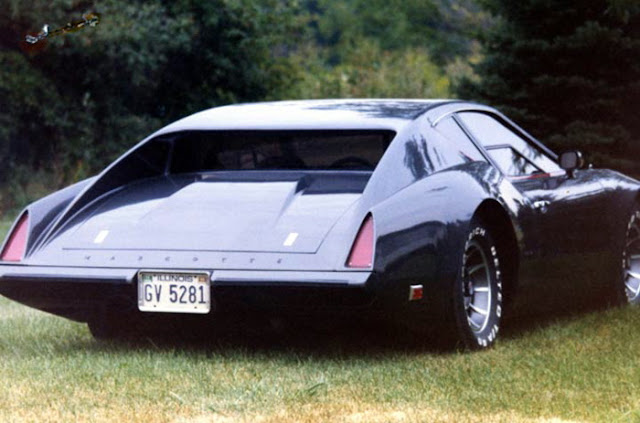Campbell and Graeme Bolwell founded their kit-car business in 1963 and within three years they were building a fastback two-seater sportscar that could hold its own against many more expensive products from the major manufacturers of the day. As the Bolwell's hands-on skills in fiberglass manufacturing techniques improved, the pair began to expand their ambitions. This would lead to their first commercial model, the Bolwell Mk. 4, selling over 200 units. It was a testament to the brother's entrepreneurial flair and dedication to the dream.
Bolwell had started the design work on the Mk7 back in 1965. The Mk7 was a clear extension of the Mk5, and was effectively targeted at the same market. In terms of styling, the Mk7 took inspirations from various sources. At the front, there was more than a passing resemblance to the Jaguar E-Type. In profile there are bits from Aston Martin, Alfa Romeo, along with an overall nod to classic GT proportions. A long hood and tires stuffed under curvaceous fenders made for a muscular look. It was far better resolved than its predecessor.
 |
| The Bolwell Mk7, at rear |
Unlike early Bolwells, with their clamshell front engine access, the Mk7 had a hood that was conventionally hinged and incorporated a bulge to provide clearance for the twin Stromberg carburetors used by early versions. The bodywork was fiberglass and bolted to a backbone chassis in the vein of Lotus cars of the era.
It's mechanicals were typically sourced from Holden donor cars including; the engine, rear axle assembly, front suspension, and both disc and drum brakes. Some Ford components were also specified including Cortina hand brake lever, XT Falcon wiper motor, Ford horn, Cortina interior light, Falcon brake and clutch master cylinders, Cortina air vents, etc.
Other Mk7 components such as headlights (Lucas), tail-lights (Toyota Crown), front parking lights (Morris 850) etc. were selected on the basis of cost and availability. The Mk7 was shipped with a bespoke laminated glass windscreen, made by Pilkington Glass. The kit was designed for easy completion with basic tools, for a builder of moderate mechanical skills.
 |
| The Bolwell Mk7 engine bay, showing the typical Holden I-6 mill installed |
The Bolwell Mk7 was introduced to the press in late 1966 and received a warm welcome. Reportedly sales got off to a brisk start as deliveries of the ready-to-build kit were soon averaging 3 per week. It total, an estimated 400 units were sold between 1967 and '72.
The Mk7's success was enough to encourage the company to develop an even more refined successor, based on an upgraded derivative of the Mk7's chassis, and designed to accept a Ford sourced V-8. That car, the "Nagari", would cement Bolwell into the hearts and minds of Aussie sportscar fans for generations to come. Look for an RCC article on that car in the future...
Most surviving examples have the standard Holden inline 6 cylinder motor under that long hood, but a handful of them were retrofitted with V-8's, bringing them to par with their newer siblings. A few also got relieved of their roof, to be turned into roadsters. Many found their way to racetracks around Australia as well, a role the package lent itself well to.
 |
| The Bolwell Mk7, in racing tune |
As was the case with other specialty carmakers, during this era, the energy crisis of the mid 70's ultimately spelled the end of the Bolwell brother's foray into the kit car business. Australian regulatory changes, enacted by the federal government, made survival very difficult for the company as safety standards required a new car to be crashed into a concrete block for test purposes. This was not an economical proposition for a small manufacturer producing less than 100 cars a year.
However, Bolwell would survive and successfully ply their fiberglass and plastics know-how in the production of a wide variety of products, from campers to marine hulls. The company has also dipped their toes back into the car market with a series of prototypes of a mid-engine Nagari successor in recent years, but that has yet to see series production.
 |
| The Bolwell Mk7, in a custom topless guise |
Among Australia's many makers of specialty cars, over the years, Bolwell remains one of the best known and most loved. The make enjoys a huge fandom in Oz and is supported by several active owner's clubs across the country. It is truly a classic marque.
 |
| The Bolwell Mk5, predecessor of the "7" |
 |
| The Bolwell Mk7, in a gathering of its siblings |
 |
| A Bolwell Mk7, in the shade |
 |
| A tastefully customized Bolwell Mk7 |
 |
| A Bolwell Mk7 racecar, in rear quarter view |
 |
| The Bolwell Mk7, in yellow |
 |
| The Bolwell Mk7, head on |
 |
| The Bolwell Mk7, in profile |
 |
The Bolwell Mk7, in yellow, with its
younger siblings, a pair of Nagaris' |
 |
| A custom Bolwell Mk7 spyder with its "Ikara" sibling |
 |
| The Bolwell Mk7 interior |
 |
| A Bolwell Mk7 in racing tune, front quarter view |
 |
| A Bolwell Mk7 racer in rear quarter view |
 |
| A custom Bolwell Mk7 spyder, at rear |
 |
| A custom Bolwell Mk7 spyder, front quarter view |
























Comments
Post a Comment